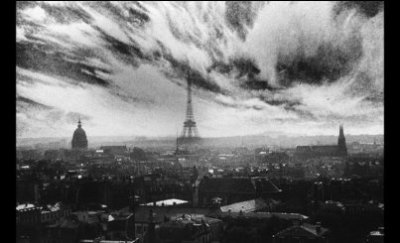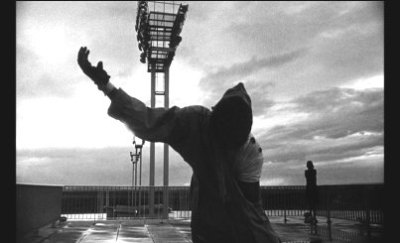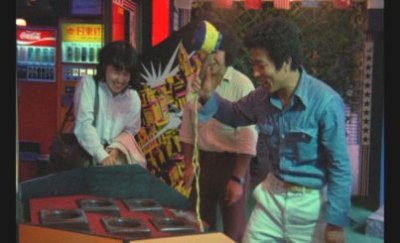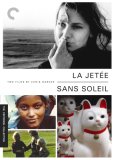| Reviews & Columns |
|
Reviews DVD TV on DVD Blu-ray 4K UHD International DVDs In Theaters Reviews by Studio Video Games Features Collector Series DVDs Easter Egg Database Interviews DVD Talk Radio Feature Articles Columns Anime Talk DVD Savant Horror DVDs The M.O.D. Squad Art House HD Talk Silent DVD
|
DVD Talk Forum |
|
|
| Resources |
|
DVD Price Search Customer Service #'s RCE Info Links |
|
Columns
|
|
|
La Jetee/Sans Soleil: The Criterion Collection
When Terry Gilliam's amazing 12 Monkeys hit movie screens in 1995, critics were clamoring over the futuristic film's fascinating source material. For many, the connection was a complete unknown. Few knew the acclaimed short subject - La Jetée - and even less were familiar with its creator, Chris Marker. A viable force in French filmmaking since the early '50s, he represented the outer fringes of the country's already controversial re-evaluation of the language of film. Unlike fellow pioneers like Godard, Truffaut, and Chabrol (among many others), Marker was a complete deconstructionist. He was not interested in making mere movies - he wanted to test the boundaries of film and its ability to capture images as a fully manipulatable medium. The aforementioned sci-fi statement may represent his most recognizable work, but there is much more to Marker than speculation and still photographs. The Criterion Collection hopes to open a window into his mannered moviemaking world by pairing La Jetée with the director's equally infamous Sans Soleil. Together, they hope to illustrate the reconfiguration of celluloid into varying elements of expression. As with most product from these preservationists, their aim is very true.

La Jetée - a small boy remembers an incident from his youth. He is on the observation deck of a familiar airport. A woman's face captures his glance. As he memorizes her smile, the delicate nature of her nose, a nearby figure wanders into his peripheral vision. Before he allows it to register, the man dies. Fast forward several years, and Paris has been destroyed as part of a global nuclear war. Radiation makes life on the surface impossible, and the underground dwellings are divided up into multi-purpose, prison-like domains. As part of an experiment in time travel, our grown hero is recruited to revisit his past, to find specific images that will allow the test to transcend physics and formulate a path backwards. After many weeks, he's successful, and soon our era explorer is meeting up with a familiar female figure. They spend time together, and explore a museum. Before long, the subject is told he is no longer useful, and will be terminated. He escapes to the future where he hopes to find peace. Instead, he is tracked by the time travelers and killed. On La Jetée - the jetty. At a local airport. In front of a small boy.
Sans Soleil - a traveling photographer sends film and commentary back to his female companion, who shows the footage and reads the remarks. Fascinated by Japan and its myriad of physical and ephemeral delights, our guide walks us through unusual temples, problematic public policies, and the lingering influence of Western culture and the after effects of World War II. In connection with this consideration, material captured in the Cape Verde Islands and other parts of coastal African expand on the notion of colonialism, and how the human desire for freedom can lead to all manner of fiery, focused reactions. As he praises the women in the area, our voyager exposes the inherent weakness in those who use power to make politics. Finally, San Francisco and its importance to Alfred Hitchcock's film Vertigo is revisited, destinations captured by the Master of Suspense explored for their lasting significance. It all passes through a place Sans Soleil - without sun - the viewfinder of a camera and the lens of a locked off artist.

It is safe to say that, in the realm of experimental filmmakers, Chris Marker bows to no man. He may borrow a bit of their celluloid sturm und drang, but his is an aesthetic formed out of calculated creativity, not crass copycatting. As a man of many talents - poet, photographer, editor, novelist - he views art as a means of understanding the world around him. He also enjoys playing with its parameters to discover his own unique philosophies. That is why, over the years, his forays into film have been viewed with awe, disdain, unbridled praise, and confused criticism. If he simply played by the rules or stayed within the strictures of the cinematic language, he'd be no different than a dozen other avant-garde auteurs. And yet the results of his multifaceted muse can be arch, difficult to decipher, and impossible to embrace on an emotional or entertainment level. Thus Criterion's release of two of Marker's main celluloid statements - 1963's La Jetée and 1983's Sans Soleil - becomes a digital litmus test for individuals only familiar with the film's through their various commercial counterparts. Many will find them fascinating, forward thinking, and fresh, while others will sense a sort of veiled familiarity with ideas and inventions that Marker may or may not be responsible for. Looking at each film individually will help clarify this direct dichotomy, as well as signal which side of the analytical assessment his work rests on today. Let's begin with:

While it may sound like sacrilege to say it, Marker's still photo sci-fi short is perhaps more influential than effective - at least for audiences four decades removed from its startling originality. Clearly influenced by his fellow Frenchmen who were reinventing film as part of their influential and endemic New Wave, Maker's made-up speculation, crafted completely out of evocative stills and subtle storytelling, can be viewed as a solid step toward a whole new level of narrative. Audience interaction was not new back in the early '60s, but requiring imagination to take the place of fundamental futurist visuals was indeed a different concept. Marker makes it very clear here that he intends the post-Apocalyptic Paris after WWIII to exist almost wholly in the mind of the viewer. Then, when the image is composed and clarified, he can fill in subtext and suggestions, guiding the patron towards their own particular meaning. Those wishing for the optical opulence of Gilliam's 12 Monkeys, or the technological tweaks that today's craftsman can create with relative ease, will need to locate such frivolity elsewhere. Marker is all about maximizing, getting the most out of his bland, static photographs while maintaining some semblance of a correlation to the genre conventions he's employing. The result is both otherworldly and grounded in recognizable reality, something few of the films that followed could ever truly claim.
Thematically, La Jetée is remarkably simple. Memories, at least for Marker, indicate select moments in time that never sway, portals that never completely disappear. They become tracking points in our existence, and should the science of time travel ever catch up with humanity's desire to journey along said continuum, they will act as anchors - final destinations, if you will, to our history. It's no wonder the movie is named after an observatory, or jetty, at the Orly Airport, as La Jetée is a narrative centering on travel. Nor is it mere coincidence that our epoch manipulating hero ends up in a natural history museum, looking at the bird displays. Be it an escape from persecution and death, or the liberation from the pain of the present, La Jetée argues for the significance of single acts, for the world turning tracks that can be traced back to a mere moment in time. Of course, Marker makes this all the more complicated by applying a kind of aesthetic algebra to his storytelling. We get snippets, fragments, and tangents, enough information to utilize on our own, but not enough to maintain its own internal integrity. Viewed without a desire to participate, without the will to overlook the purposefully placed cinematic stumbling blocks, it can be tough going. But upon giving into Marker's manipulations, a whole new world is unveiled.

Easily described in a single sentence - a post-modern Mondo Cane - Sans Soleil is a travelogue without tense, a pictorial without obvious purpose. When taken out of its creative context, when viewed in terms of its tri-fold subjective approach (Africa, Japan, and Hitchcock's Vertigo) it appears to be nothing more than pretty pictures juxtaposed with some sobering text (read by an off screen female narrator). Observational in the most literal sense of the word, the visual and prose components gel to form a singular, subjective world view, a meditation on everything that makes cultures unique, heritage importance, and human beings so engaging. Marker is not dissuaded from using controversial or horrific images or ideas. During the course of Sans Soleil we are witness to a gory giraffe killing (complete with vulture aftermath), a condemnation of the Japanese system of censorship (where the blurring out of the pubis actually increases titillation), and a weird recreation of the Kama Sutra with sexually explicit images of copulating monkeys. As with the shocking images Franco Prosperi and Gualtiero Jacopetti used to highlight the foibles and flaws in the universal condition, Marker is making a statement about the illusion of illustration, and how what we see is not always the purpose behind a picture. There are layers to life, and within each photograph or representation of same passes a thousand equally important interpretations. None are right. All are wrong. And visa versa.
This can all get very heady, especially when our guide goes overboard with the scholarly spiel. For example, the camera catches a commando raid, African guerillas fighting for freedom from the oppression and anger they feel. But instead of focusing on said struggle, the dialogue de-evolves into a perplexing personal problem, the writer feeling sorry for ever using this type of armed forces terminology to describe his own artistic efforts. Similarly, we are witness to a pre-coup military ceremony where the soon to be deposed leader bestows medals on the very men who will unseat him in office. It's a startling sequence, but the narration tends to temper the impact, going overboard into the metaphysical meaning of such a karmic coincidence. Part of the problem with Sans Soleil, one that falls completely out of what Marker was trying to achieve 25 years ago, is the notion of globalization. The Mondo movies became infamous for opening up otherwise closed off cultures to the rest of the world. Similarly, this film is still fascinated with the unusual aspects of Japan, things we now take for granted (pop culture reinvention, religious micromanagement). The ready availability of information in 2007 more or less dampens the impact of his discoveries. The Africa material is more enlightening, but takes a clear backseat to the Asian angle. We may be smarter than Marker was at the time of Sans Soleil's creation, but his is a very dense expressionist dynamic. In that regard, he remains several steps ahead of his audience.
Indeed, it's apropos to state that Marker is a moviemaker that found time finally catching up with his previously unstuck epics. It's easy to see why both La Jetée and Sans Soleil were confounding upon their initial release. There was nothing else like them in the current cultural conversation. The Mondo movies had made their mark, but after their initial splash, satellite news and world broadcasts replaced their border-evaporating entertainment. So when Marker made his cinematic comment, he was doing so out of an old dynamic that now seemed more foreign than ever. Similarly, there were interesting mainstream examples of science fiction cinema long before this director decided to explore the genre's particulars. But La Jetée was the first film to try and craft the fantastical out of the facile and plain. There's no Metropolis like vistas or Forbidden Planet style designs. Instead, Marker made ideas more important than images, taking the format as far away from its 'moving' picture base as possible without ever denying the medium's meaning. There will be a few fans who can't fathom the importance that either film maintains - not as part of the cinematic categories they represent, or as part of the grand scheme of film overall. But if you look beyond what Marker is doing and, like jazz, recognize what he's NOT relying on, the brilliance begins to shine through. La Jetée and Sans Soleil definitely deserve their particular praise. They may not mean much to the modern movie maven, unfortunately.
The Video:
Typical of the care and consideration Criterion gives to every release, La Jetée/ Sans Soleil both look stunning in their 1.66:1 anamorphic widescreen transfers. The pale, graying monochrome used in the first film truly helps provide a feeling of disquieting temporal distance. Equally evocative are the crazy quilt colors of Sans Soleil's gonzo globe trotting. The details are clear and concise (sometimes, unsettlingly so) and the 'borrowing' of other material from like minded moviemakers (Marker admits to such stock footage foundations) meshes perfectly with the director's designs. Some may feel the images are a little unexceptional, lacking the visual vibrancy of a typical DVD release, but given their format, and their rarity, La Jetée/Sans Soleil look very good indeed.
The Audio:
On the sound side, we are given the opportunity to hear the original French versions of both films, as well as the perfectly acceptable English dub tracks created for international release. The subtitles accompanying the foreign language edition are excellent, easy to read and readily understandable. They capture the ideas and emotions prevalent in each offering. For those aggressive audiophiles out there, the Dolby Digital Mono mixes are nothing exceptional, but then again, they are not overmodulated or distorted. They do the sonic job they are meant to, and that's all that matters.
The Extras:
Originally announced as a much larger two disc package (including commentaries and other added context), Criterion has since shrunk down their presentation of these two films. But this does not mean that there's a dearth of information. Indeed, there is some amazing material here, all used to clarify just who Marker is, and why he's considered so influential. While the filmmaker himself is missing from the discussion, we do hear from noted French auteur Jean-Pierre Gorin. Both a critic and a colleague of Marker's, as well as a collaborator of Jean-Luc Godard's, he covers a great many subjects, including the director's particular connection to other artforms and his continuing fascination with mathematics. There is also a video piece by filmmaker Chris Darke about Marker, as well as two pieces from French television. One centers on the obvious influence of La Jetée on David Bowie and his video "Jump They Say". The other is a discussion of Vertigo and its lingering impact on Marker and his movies. Together with a monumental booklet featuring essays and interviews, we begin to peel back the layers on this artist's formidable achievements. They add the background we require to fix his final place in the motion picture hierarchy.

How does one recommend a DVD destined to divide opinion? Is it fair to tell film fans that they will be missing something truly original if they avoid a particular title, while also acknowledging that there are inherent aspects to the release that may keep them from completely enjoying the experience? That's the dilemma facing anyone interested in Chris Marker and his influential La Jetée/Sans Soleil. Criterion does its typical stellar job, and when placed within the time frame they were created in, both movies stand as important motion picture landmarks. And yet one has this sneaking suspicion that modern audiences, overdosing on YouTube and CGI, will shrug their shoulders and sigh. Whatever the case, this critic cannot deny Marker's importance, and has no problem pronouncing a final score of Highly Recommended. But be forewarned - Marker's universe is a calculated and confused domain. You may find yourself falling into it naturally. You could also be left standing outside, unable to withstand its perplexing purpose. One senses this filmmaker wouldn't have it any other way.
Want more Gibron Goodness? Come to Bill's TINSEL TORN REBORN Blog (Updated Frequently) and Enjoy! Click Here
|
| Popular Reviews |
| Sponsored Links |
|
|
| Sponsored Links |
|
|
| Release List | Reviews | Shop | Newsletter | Forum | DVD Giveaways | Blu-Ray | Advertise |
|
Copyright 2024 DVDTalk.com All Rights Reserved. Legal Info, Privacy Policy, Terms of Use,
Manage Preferences,
Your Privacy Choices | |||||||













